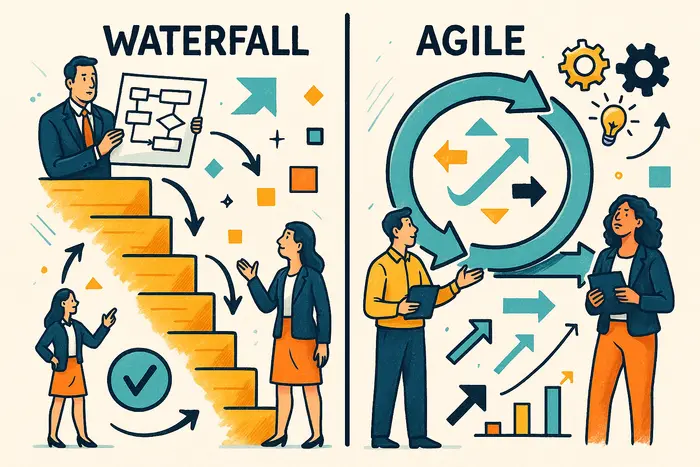Waterfall vs Agile: Which Project Management Method Is Right for You?
Choosing the right project management methodology can make or break your project’s success. Two of the most well-known approaches are Waterfall and Agile. Each offers a distinct way to plan, execute, and deliver projects.
In this article, we’ll break down the core differences, benefits, drawbacks, and use cases for Waterfall and Agile. Whether you’re a business owner, project manager, or team lead, you’ll learn how to choose the best fit for your needs.
What Is the Waterfall Methodology?
The Waterfall model is a linear and sequential approach to project management. Think of it like a staircase: you complete one step before moving on to the next.
Key Characteristics:
- Structured phases: Requirements → Design → Implementation → Testing → Deployment → Maintenance
- Heavy upfront planning
- Fixed scope and timeline
- Minimal client involvement after kickoff
Pros:
- Clear documentation and expectations
- Easier to manage large teams with defined roles
- Good for regulatory or contract-driven industries
Cons:
- Inflexible to changes mid-project
- Risk of delivering a product that no longer meets user needs
- Delayed feedback until the end
What Is the Agile Methodology?
Agile is an iterative and flexible approach. Work is broken into short cycles (often called sprints), with regular feedback and adjustments.
Key Characteristics:
- Iterative development in small increments
- Continuous collaboration and feedback
- Changing requirements welcomed
- Teams self-organize and prioritize
Pros:
- High adaptability to change
- Early and frequent user feedback
- Continuous improvement through retrospectives
Cons:
- Requires strong communication and discipline
- Less predictability in timeline and budget
- Can be hard to scale in large organizations
Waterfall vs Agile: A Side-by-Side Comparison
| Feature | Waterfall | Agile |
|---|---|---|
| Approach | Sequential | Iterative |
| Planning | Upfront | Adaptive |
| Flexibility | Low | High |
| Client Involvement | Low after kickoff | Continuous |
| Deliverables | At the end | In increments |
| Best For | Predictable, well-defined projects | Dynamic, evolving projects |
How to Choose Between Waterfall and Agile
Here’s a quick decision checklist to help you pick the right method:
Choose Waterfall if:
- Requirements are clear and unlikely to change
- The project is short and straightforward
- You’re working in a regulated or contractual environment
- Stakeholders want detailed documentation and predictable delivery
Choose Agile if:
- Requirements may evolve over time
- You’re developing something new or innovative
- You want to involve users throughout the process
- Your team is comfortable with iterative development
Hybrid Models: The Best of Both Worlds?
In reality, many teams use a hybrid approach, blending Waterfall planning with Agile execution. For example:
- Use Waterfall for high-level planning and compliance
- Use Agile sprints for building and testing features
This approach can balance predictability with flexibility.
Summary: Make Methodology Work for You
Both Waterfall and Agile have their strengths. The best choice depends on your project’s nature, your team’s culture, and your stakeholders’ expectations.
Key Takeaways:
- Waterfall = structured, predictable, best for fixed-scope projects
- Agile = flexible, collaborative, best for changing environments
- Consider hybrid models when you need elements of both
Choosing the right method isn’t about being trendy—it’s about being effective. Pick the approach that helps your team deliver the most value, with the least friction.
